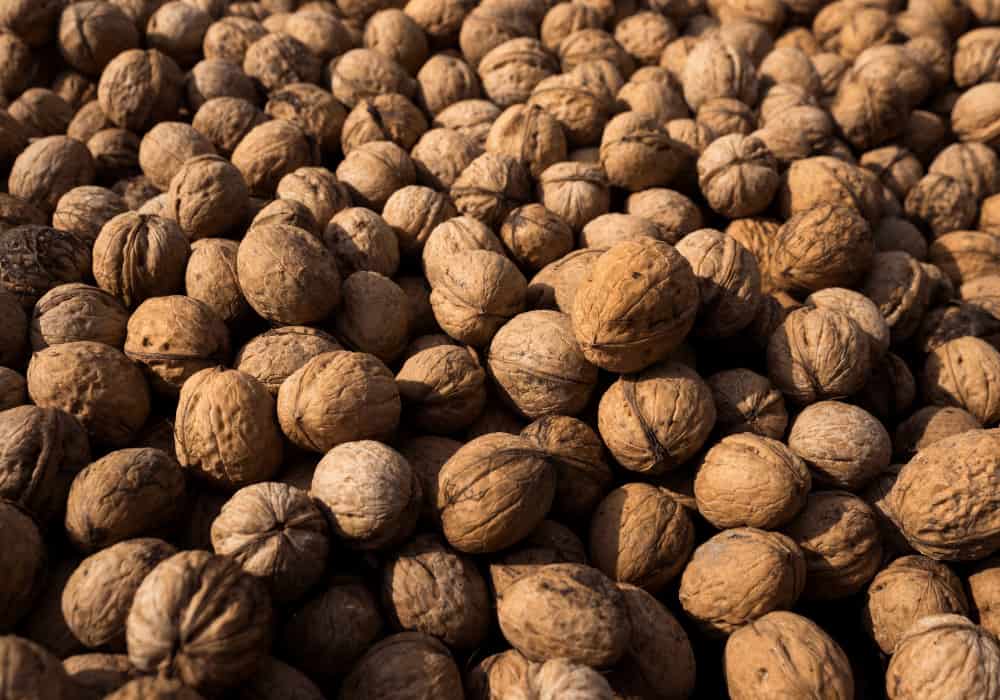The Legend of Bacchus
The history of how walnuts came to California began with the legend of Dionysus, also known as Bacchus. Dionysus is the Greek God Of Wine (and God of other worldly pleasures) who fell in love with a princess named Carya.
Carya has sisters who were quite jealous of their relationship. They made attempts to keep Carya away from Bacchus, causing him anger and frustration. In his anger, he is said to have turned the sisters into stone. In conclusion of the tale, he then transforms his lover into the first walnut tree.

The legend certainly doesn’t make much sense, but, this is the telling.
If the story holds any truth, Bacchus created one of our most valuable trees that provided wood for furniture and construction. More commonly known, the walnut tree provided a variety of nuts that have historically sustained populations in times of need.
Almost all of the world’s marketable walnuts today are Juglans Regia, the Persian walnut. At the time, the man was said to live on acorns. Bacchus and his fellow Gods ate the best acorns with the word Juglans meaning “Jupiter’s Acorns” and Regia meaning “Royal.”
Ultimately, we know that mythology is not the same as trusted archeology.
This species of walnut is so widely scattered over the globe that it’s difficult to know exactly where it originated. South Central Asia seems most likely based on what we know. We know that archeologists have uncovered walnut shells as much as 9,000 years old. The history of walnuts shows them being found in the ruins of Pompeii. This indicates that they came as far as southern Italy over 2,000 years ago. Nuts have long been popular in European Cuisine.
Over time, the Persian Walnut was taken to the Americas. Established in almost every temperate area visited by traders and explorers. Traders brought such large quantities of them to England, that they were sometimes called the English Walnut, even though they were Persian.

Persian Walnuts came to California with Franciscan Priests around the late eighteenth century. It became a significant crop in the middle of the nineteenth century. In 1912, the Diamond Walnut cooperative was established in Stockton, California.
The walnut is popular everywhere because it is hardy, grows well, and is easy to crack. There are currently many different species growing in California. No other species, however, claims commercial cultivation like the Persian Walnut.
Historical Medical Benefits Of Eating Walnuts
The history of walnuts covers a long list of ancient cures that the walnut was once used for, ranging from autism to concussions. A walnut resembles a brain, and in the Middle Ages was thought to be “brain food” or even “brain medicine”. Correspondingly, sufferers of mental illness would receive advice to eat a lot of walnuts. There are beliefs that walnuts create fertility in women. For that reason, they are sometimes thrown at weddings to encourage pregnancy.

The Future of California Walnuts
Nurseries often use a rootstock from a northern California black walnut species to plant new trees. It is a tough, hardy, and disease-resistant tree. When the farmers plant the orchards, the trees find placement thirty feet apart to optimize them. They are eventually producing when they reach between six and eight years old. The orchard is will experience thinning out when they become too large. Mature walnut trees need a space of fifty feet and can live a very long time when properly cared for. There are even century-old walnut trees that are still successfully producing crops.
In conclusion, whether it’s due to health benefits, fun history, or just taste alone, walnuts are a nutritious dietary addition. One that is readily available in the United States. Due to its historical growth in California walnuts have become part of the culture.



